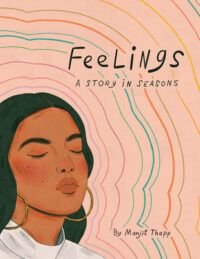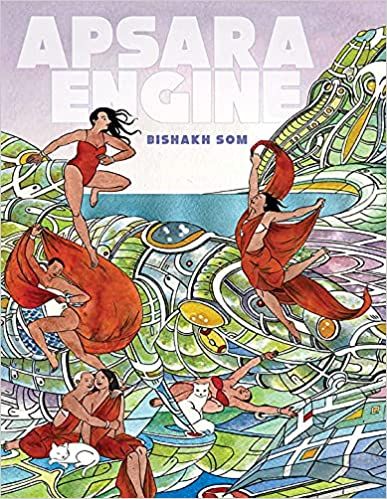An obsessive rereader, I added a “revisited” shelf and a “want-to-reread” shelf on Goodreads. When I realized that I hadn’t reread any graphic novels or memoirs, it struck me as weird. On our living room bookshelves, I reserve a special section for art, everything from picture books to comics to Frida Kahlo in alphabetical order by title, so I can reference them easily. On whims, I pull them down to gaze at illustrations and let the images seep into my brain.
One of the many things I adore about graphic books is how fast you can finish them. A slow reader, I rarely read something in one sitting, even novellas and poetry collections, so the invaluable feeling of devouring a title in a weeknight satisfies me. But I wonder, while flipping those pages in feverish love, did I miss anything? I return to a few favorites to find out.
During a bout of homesickness for Hawai‘i, I reach for No One Else by R. Kikuo Johnson. In a conversation with Lee A. Tonouchi for HONOLULU Magazine, Johnson says, “I love reading a comic that really requires you to look very closely at the drawings and experience the story through the drawings as much as through the text.” This trip through the quiet graphic novel set on Maui, near my hometown, I look closer.
With my index finger, I trace the appearance of orange. On the cover, wild flames encroaching on the fence, the stripe and buoy on the boat parked in the family’s overgrown backyard. In the beginning pages, I admire echoing orange circles: the sun above a sugarcane mill, the title enclosed in (I’m guessing here) a larger sun, then a similarly sized cheeseball in the identical place on the following page-turn. Moving along, I note the bright blanket, cheese dust, real and dreamed fire, and muted memories and flashbacks. I gawk at the crackle of color against the black, white, gray, and blue-toned illustrations.
In the panels, I notice, and sometimes notice again, a crescent moon through the upstairs window, a flower adorning pulled-up hair, mountains looming in the background, the dependable combination of board shorts and slippers, feral chickens at the gas station. The untouched ramen with nori and egg Robbie places at young Brandon’s bedroom door still breaks my heart. As I had hoped, rereading No One Else shortens the distance between my current reading spot in the Gulf Coast and the Islands.

After the two shots in my arm fully marinated, I happened upon Feelings: A Story in Seasons during my first in-person bookstore visit in more months than I can display on fingers. Since admiring Manjit Thapp’s illustrations in The Little Book of Feminist Saints by Julia Pierpont, I’ve been a fan, but somehow this had slipped past my attention. So, you can imagine my masked joy to discover this graphic novel that unfolds through six seasons, based on the calendar of some South Asian countries, in an empty aisle of Octavia Books.
In the lower left corner of the cover, a portrait of a dark-haired woman, eyes closed, with a middle part and gold hoop earrings appears. In that image, I think I saw a little of myself and opened the book. Serendipitously, Thapp writes in the author’s note, “I strove to capture the emotional authenticity of my seasonal experiences with anxiety. Perhaps you’ll see yourself in her too.”
While rereading, I see more and more of myself: curiosity about creative practices and inspiration; obsessions with flowers, plants, the moon, and the sun; a life punctuated by to-do lists and calendars; noodles twirled onto a fork; canceled plans and chocolate. I ooh and ah over the color palette of this book like a sunset. Every Friday or so, the pinks and blues populate my brain, and I smile. Is it possible to be haunted, in a good way, by color? Other color palettes and artwork on repeat in my mind: Mariko Tamaki’s Laura Dean Keeps Breaking Up with Me, illustrated by Rosemary Valero-O’Connell; and Sloane Leong’s A Map to the Sun.

Recently, I reread “Somaly Serey, Serey Somaly” from Anthony Veasna So’s Afterparties over lunch and wondered, Why don’t I do this more? Inspired and motivated, I choose my second story of the week. The poetic language of “Love Song” from Bishakh Som’s Apsara Engine has been calling to me since I shelved the graphic story collection. In “Queer Disruptions: Talking with Bishakh Som” by Vidhu Aggarwal, Som states, “I think comics have really claimed a space in representing time, movement, and space visually. Comics have been undervalued for so long, written off as cheap — but we know this art form has really deep, rich possibilities.” As I reread, I look deeper.
The only story of the eight featuring cursive, the lettering in the beginning of “Love Song” gives the text a handwritten-letter feel. Enclosed between quotation marks, do the cursive words belong to an off-the-page someone and not the character in the haunting watercolor images with a cropped hairstyle and knee-length dress leaving a house then walking to a bench? After a finger-hungry creature drops the protagonist from the sky, the lettering switches to print sans quotation marks, meditating on the losses of cousins, Auntie Sarita, Selina, and more.
With The Rumpus conversation between Aggarwal and Som fresh in my mind, I read the story again, paying attention solely to the images: fuzzy trees and cloudlike bushes. I read it again, paying attention solely to the writing. After my third and fourth looks, I’m left with impressions of joy, solitude, generosity, estrangement, suffering, confusion, resistance, comfort, and peace. Phrases like “the damaged poet with lank hair” and “Honey-child” and stunning images stay with me, especially the final one. To avoid spoilers, I won’t describe it here, but I hope you seek it out for yourself.
While slowing down with graphic novels and stories, I recognize that looking closer in books urges me to look closer in life. In the blurry mire of a busy January, these stories push me to be present. I observe what falls across my eye line: eerie night shadows, a yellow butterfly. I glimpse my surroundings often. Next to the recliner, a toppled Polaroid picture, a maroon hair bow. On the coffee table, lilies hours from blooming, tap water purpled in the vase. In the foyer, a wilting Fraser fir doing an impeccable Leaning Tower of Pisa impression.
If rereading and graphic memoirs interest you, check out this post’s older sister, On Slowing Down With Graphic Memoirs.
Source : On Slowing Down With Graphic Novels And Stories: Rereading The Favorites I Devoured












